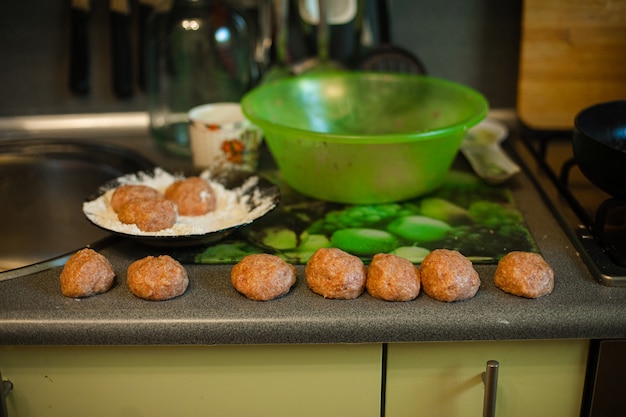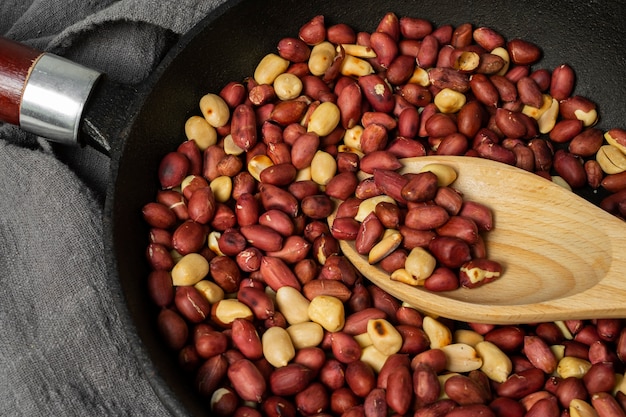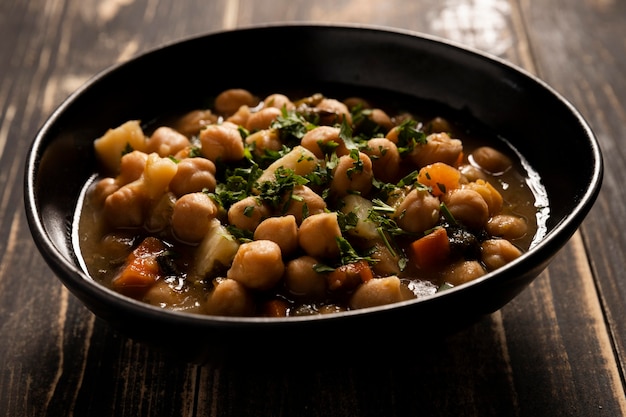You've got a bag of those lovely, plump lima beans, and you're ready to whip up a delicious dish. But hold on a minute, how long do you cook them for? Don't worry, I've been there, standing in front of the stove, wondering if those beans are ready yet, and let me tell you, it can be a bit of a head-scratcher. But fear not, my fellow foodie, because I'm about to share my tried and true methods for perfect stovetop lima beans. Get ready to learn some tips and tricks that'll make your bean game strong!
(Part 1) The Basics: Understanding Lima Beans

Before we dive into the details of cooking time, let's take a quick look at what we're working with. Lima beans, also known as butter beans, are a versatile legume with a mild, slightly sweet flavour. They're packed with protein and fibre, making them a healthy and hearty addition to any meal. But the key to getting them just right is knowing how to cook them properly.
The Different Types of Lima Beans
Now, there are two main types of lima beans you'll likely encounter: fresh and dried. Fresh lima beans, usually sold in pods, have a slightly firmer texture and a fresher taste. Dried lima beans, on the other hand, need to be soaked before cooking and have a more intense flavour.
For the purpose of this guide, we'll be focusing on dried lima beans, as they're the most common type found in grocery stores. Now, let's get down to business and talk about the magic number - the cooking time!
(Part 2) The Perfect Stovetop Lima Bean Cooking Time: A Breakdown

You've got your dried lima beans, you've soaked them overnight, and you're ready to cook them up. But how long do you simmer those little fellas? It's all about finding that sweet spot, where they're tender and delicious but not mushy. Here's a breakdown to guide you:
1. Pre-Soaking: The Essential First Step
First things first, let's talk about soaking those beans. Soaking dried lima beans is crucial for a couple of reasons. Firstly, it helps soften them up, making them easier to cook. Secondly, it reduces cooking time, saving you precious time in the kitchen.
Here's how I do it: I usually soak my lima beans overnight in plenty of fresh water. Just make sure they're fully submerged. A good rule of thumb is to use about 4 cups of water for every cup of beans. You can also use a quick soak method, where you boil the beans for 2 minutes, then let them sit in hot water for an hour. Either way, the soaking is a crucial step, so don't skip it!
2. The Boiling Point: It's All About the Simmer
After soaking, drain those beans and rinse them well. Then, add them to a large pot with fresh water, making sure the water level is about 2 inches above the beans. Bring the pot to a boil, then reduce the heat to a gentle simmer.
Now, here's where it gets interesting. The cooking time for dried lima beans can vary depending on a few factors, like the age of the beans and how long you soaked them. Generally, older beans will take longer to cook. However, as a general rule of thumb, you can expect to simmer them for around 45 minutes to 1 hour.
3. The Tenderness Test: Don't Be Afraid to Check
I'm a firm believer in checking those beans regularly, just to make sure they're cooked through. After about 30 minutes, start testing a few beans by mashing them with a fork. If they're tender and easily mashed, you're good to go. If not, keep simmering for another 10 minutes or so and check again. Don't worry about overcooking them, as long as they're not mushy, they'll still be delicious.
4. Salt and Seasoning: Adding That Extra Touch
Once the beans are cooked, you can season them to your liking. I usually add a pinch of salt and a bit of black pepper, but you can get creative and add any herbs or spices you fancy. Some people like to add a bay leaf for extra flavour, which is a nice touch.
(Part 3) Tips and Tricks for Perfect Stovetop Lima Beans

Now that you know the basics, let's dive into some handy tips and tricks that will take your lima bean game to the next level.
1. Use a pressure cooker for Faster Cooking
If you're short on time, a pressure cooker can be your best friend. You can cook dried lima beans in a pressure cooker in about 20 minutes, which is much faster than the stovetop method. Simply follow the instructions for your specific pressure cooker and enjoy those tasty beans in no time. Just be sure to release the pressure carefully, as hot steam can be dangerous.
2. Add a Little Acid for Tenderness
A little bit of acidity, like a splash of lemon juice or vinegar, can help break down the tough outer layer of the beans, making them even more tender. Just add a tablespoon or two of lemon juice or vinegar to the pot during the last 15 minutes of cooking.
3. Don't Overcook Those Beans
Just like any other legume, overcooked lima beans can become mushy. Once those beans are tender, take them off the heat and enjoy. Don't worry, they'll stay warm for a while. If you do happen to overcook them, don't despair! You can still use them in soups, stews, or even blend them into a delicious dip.
4. Save the Cooking Liquid: A Versatile Ingredient
Here's a pro tip: Don't throw away that bean broth! It's packed with flavor and can be used for soups, stews, or even as a base for a delicious sauce. Just strain it through a fine-mesh sieve to remove any solids. This liquid, also known as aquafaba, is a great vegan egg substitute in baking.
5. Storage: Keeping Your Beans Fresh
Cooked lima beans can be stored in an airtight container in the refrigerator for up to 3 days. You can also freeze them for longer storage, up to 3 months. Just make sure to defrost them thoroughly before using. You can defrost them in the fridge overnight, or quickly in a microwave or saucepan on the stovetop.
(Part 4) Delicious Ways to Enjoy Lima Beans
Now that you've mastered the art of cooking perfect stovetop lima beans, it's time to put them to good use! Here are a few delicious ways to enjoy them:
1. A Classic: Lima bean salad
This is a simple and refreshing dish that's perfect for warm weather. Just mix your cooked lima beans with chopped celery, onion, and a light vinaigrette. You can add other veggies like bell peppers, tomatoes, or even a handful of fresh herbs for extra flavour and texture.
2. Hearty and Comforting: Lima bean soup
Lima beans are a great addition to soups, adding a creamy texture and a satisfyingly hearty flavour. Combine them with other vegetables like carrots, celery, onions, and some spices like cumin, coriander, or turmeric for a delicious and nutritious soup.
3. A side dish Delight: Lima Beans with Herbs
A simple side dish that complements a variety of main courses. Just toss your cooked lima beans with fresh herbs like parsley, dill, or chives. You can also add a splash of lemon juice or a drizzle of olive oil for extra flavour.
4. A Festive Favourite: Lima Bean Casserole
This is a classic casserole that's perfect for potlucks or family gatherings. Combine your cooked lima beans with other vegetables like corn, peas, and carrots. Top with a crispy breadcrumb topping and bake until golden brown. You can also add cheese for a richer flavor.
5. A Vegetarian Staple: Lima Bean Burgers
Looking for a vegetarian burger alternative? Look no further! Simply mash your cooked lima beans with oats, breadcrumbs, and seasonings. Shape them into patties and cook them on the grill or in a pan until they're golden brown. You can add chopped veggies like onions and mushrooms for extra flavor and texture.
(Part 5) Exploring the World of Lima Bean Dishes: A culinary journey
The culinary world is a vast and exciting place, and lima beans play a starring role in many different cuisines. From the vibrant flavours of Latin America to the hearty dishes of the Caribbean, lima beans are a beloved ingredient that adds depth and texture to a wide array of meals.
1. Latin American Delights: A Taste of the Tropics
In Latin America, lima beans are a staple ingredient in many traditional dishes. They're often used in stews, soups, and salads, and they bring a unique flavour and texture to the cuisine. One of the most popular lima bean dishes is frijoles de la olla, a hearty stew that's typically made with pork, vegetables, and spices. It's a comforting and satisfying dish that's perfect for a cold day. You can also find lima beans in arroz con gandules, a Puerto Rican rice dish made with pigeon peas, sofrito, and pork.
2. Caribbean Flavours: A Spicy and Aromatic Journey
The Caribbean is known for its vibrant and spicy cuisine, and lima beans are an important part of it. They're often used in rice and beans, a classic Caribbean dish that's typically made with rice, beans, and a variety of vegetables. You can find different variations with different spices and meats. They're also a key ingredient in callaloo, a traditional Caribbean soup made with spinach, okra, and spices. The soup can be seasoned with coconut milk, scotch bonnet peppers, or other spices depending on the region.
3. Southern Hospitality: A Taste of the American South
In the American South, lima beans are often used in hoppin' John, a traditional dish that's typically made with black-eyed peas, rice, and pork. It's a dish that's often served on New Year's Day for good luck and prosperity. You can also find lima beans in Southern-style collard greens and potlikker, a flavorful broth made from cooking collard greens.
(Part 6) Lima Beans and Nutrition: A Health Boost
Let's face it, we all want to feel our best, right? And that means making healthy food choices. Well, guess what? Lima beans are a nutritional powerhouse! They're packed with protein, fibre, and essential vitamins and minerals, making them a valuable addition to your diet.
1. Protein Power: A Vegetarian’s Dream
Lima beans are a great source of protein, especially for vegetarians and vegans. They're a complete protein, meaning they contain all nine essential amino acids that our bodies need. A cup of cooked lima beans contains about 15 grams of protein, making them a satisfying and nutritious choice.
2. Fibre Fiesta: Keeping You Feeling Full and Satisfied
Fibre is an important part of a healthy diet, and lima beans are a fantastic source of it. Fibre helps regulate digestion, lowers cholesterol levels, and keeps you feeling full and satisfied after meals. A cup of cooked lima beans contains about 15 grams of fibre, which is about 60% of the recommended daily intake.
3. A Vitamin and Mineral Bounty: Nourishing Your Body
Lima beans are a good source of a variety of vitamins and minerals, including folate, iron, magnesium, and potassium. Folate is important for cell growth and development, while iron helps carry oxygen throughout the body. Magnesium plays a role in muscle function and blood sugar control, and potassium is essential for maintaining fluid balance and blood pressure.
(Part 7) Lima Bean Cooking: From Beginner to Expert
So you've got a newfound appreciation for lima beans, but you're wondering where to go from here. How do you level up your lima bean cooking game? Don't worry, I've got you covered. Here's a guide to take you from beginner to expert:
1. Mastering the Basics: A Foundation for Success
Start with the basics. Get comfortable with soaking, cooking, and seasoning your lima beans. Once you've mastered the fundamentals, you can move on to more advanced techniques.
2. Experimenting with Flavours: Unleashing Your Creativity
Don't be afraid to experiment with different flavours and spices. Try adding herbs like rosemary, thyme, or oregano, citrus like lemon or lime, or even a touch of chili for a kick. The possibilities are endless! You can also try incorporating different types of vinegar, such as apple cider vinegar or balsamic vinegar, for a tangy twist.
3. Exploring Different Dishes: Expanding Your Culinary Horizons
Once you've mastered the basics, start exploring different dishes that feature lima beans. Try making a classic lima bean salad, a hearty soup, or a festive casserole. You can also find inspiration from international cuisines.
4. Finding Inspiration: Discovering New Ideas
Look for inspiration from cookbooks, magazines, or online resources. There are countless recipes that feature lima beans, so you'll never run out of ideas. You can also check out recipe blogs, food websites, and culinary forums for inspiration.
(Part 8) FAQs: Your Lima Bean Questions Answered
I've been there, you've been there - we've all had those burning questions about lima beans. So here are some answers to the most common questions:
1. How long can I soak lima beans before cooking?
You can soak lima beans for anywhere from 4 to 12 hours. Overnight soaking is ideal, as it gives the beans plenty of time to soften up. If you're short on time, a quick soak for 1-2 hours will still be helpful.
2. Can I cook lima beans without soaking?
You can, but it will take longer to cook and the beans may not be as tender. Soaking is always recommended for best results.
3. What if my lima beans are still hard after cooking?
If your lima beans are still hard after the recommended cooking time, they may be old. Try soaking them again for a few hours and then cooking them for a longer period. If they're still hard, they may be past their prime and should be discarded.
4. What can I do with leftover lima beans?
Cooked lima beans can be used in a variety of dishes. You can add them to salads, soups, stews, or even make them into a spread for sandwiches. They also make a great addition to breakfast burritos, wraps, or bowls.
5. Are lima beans good for you?
Yes, lima beans are a healthy and nutritious food. They're a good source of protein, fibre, vitamins, and minerals. They're also low in calories and fat, making them a great choice for weight management.
(Part 9) Conclusion: A Love for Lima Beans
Well, there you have it, mate! That's my guide to perfect stovetop lima beans. From the basics of soaking and cooking to tips and tricks for achieving the ultimate tenderness and flavour, I've shared everything I've learned over the years. Lima beans are a versatile and delicious ingredient, and with a little practice, you can become a true lima bean aficionado. So go forth, my fellow foodie, and unleash your culinary creativity with these amazing legumes! Happy cooking!
Everyone is watching

Corn on the Cob: The Ultimate Guide to Perfectly Cooked Ears
Healthy MealsAh, corn on the cob. Just the name evokes images of sunny days, barbecues, and that sweet, juicy flavour that ...

Perfect Pork Roast Oven Cooking Time: A Guide to Delicious Results
Healthy MealsThere's something truly satisfying about a perfectly roasted pork. The aroma alone is enough to make your mout...

Ham Cooking Time: How Long to Bake, Smoke, or Boil a Delicious Ham
Healthy MealsAh, ham. It's a classic, isn't it? A real crowd-pleaser, especially around holidays. And when done right, it'...

Scallops: The Ultimate Guide to Perfect Cooking
Healthy MealsAh, scallops. Those delicate, sweet, and utterly delicious morsels of the sea. They hold a special place in my...

Spaghetti Squash: The Ultimate Guide to Cooking and Serving
Healthy MealsRemember that time you saw spaghetti squash at the supermarket, looking all bumpy and strange, and thought, "W...
